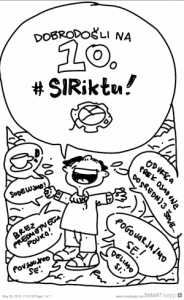Katarina Tadić in Renata Flander, Osnovna šola Davorina Jenka, Cerklje na Gorenjskem
Being part of Erasmus+ project we have tried out a method of a flipped classroom, which gives students an opportunity to take responsibility for their own learning. We asked students in home economics to come up with the story about muffins and in maths with the story about equations, which is about to be described in greater detail. Students need a tablet or a smart phone to work. A teacher prepares the instructions using the Google presentations tool and sends the access to the documents in a form of a QR code. The main goal is for students to be able to solve equations. They work in pairs. As an introductory motivation they watch a video about how to solve an equation using Photomath application. They discuss the video, naming advantages and disadvantages of using the application. Based on their findings they make a video about how to solve an equation using Storio, PicPac or Animoto applications. They go about solving an equation step by step, recording each step by a camera. They express the gist of each step in short since there is a limitation to how many signs can be used. In this way they come up with the instructions themselves and add them to the document in Google presentations. The lesson ends with random equations given by the teacher when students can check which video and whose instructions are most useful and valuable. The motivation is very high on the part of the students as they are able to use their own devices. A motivated student is more likely to learn successfully. The use of Storio, PicPac and Animoto applications is easy, appropriate for students of all ages- however, it is necessary to know a few basic English words (done, create, save, etc.). Not only do students learn technical language, but the study material they use is also useful to anyone who misses classes. It is not always true that students with A’s are the most successful ones. What is important is that they acquire knowledge in different ways, that they are able to find the most suitable ways of learning for themselves, that they have access to their knowledge in any given moment and can share their knowledge with others.
